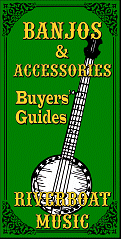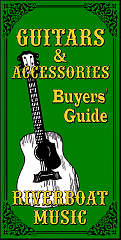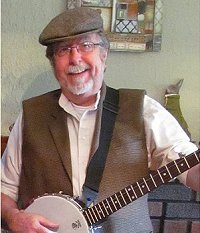


|


Momma Don't 'Low? is a newsletter to support acoustic and traditional music, as well as the folks who follow our music articles on various web pages, including Creek Don't Rise?, Classic Train Songs?. SchoolOfTheRock?, and PaulRaceMusic.com
- If you did not get this Momma Don't 'Low? newsletter through your own e-mail, and you would like to get the newsletters in the future, please Click Here to sign up.
- On the other hand, if you don't want to receive our e-mail updates, please e-mail me with a "Please Unsubscribe" message (worded any way you wish), and we will graciously remove you from our list.
 In this Issue - October, 2016
In this Issue - October, 2016
If this newsletter seems unfamiliar, it's either because:
- You signed up for Paul Race's mailings within the last several months, or
- You haven't gotten a Momma Don't 'Low newsletter since last November.
A lot of water has gone under the bridge since then. We have updated several music pages, added many articles, and heard from readers from the UK to NZ. We have added useful links and articles, and I've done concerts and clinics of various kinds.
So we could say we've been too busy to put out a newsletter. But the biggest obstacle to keeping up with this is that we have had to move our sites to different hosting servers, and every move caused a mess of problems that took a long time to sort out and fix.
Recently, we were encouraged to add SSL to our sites because of Google changing their search algorithm again (that's why the URL box at the top of your browser starts with "https" unstead of "http."). But that forced us to make other changes. It also meant that there was a two-week period in which clicking on most of our sites would just give you an error like "this site's SSL is so screwed up that clicking through to it will cause your dog to die and your children to turn into gremlins" or some such. It's better now, though. The messages simply threaten that your dog will throw up on the carpet and your children will vote Republican.
I don't usually get newsletters out every month, but I seldom go this long between them. So rather than trying to list everything that's happened in the past eleven months, we'll just hit the high points with this one.
Here's a change that's kind of broad: after spending years creating resources for and coaching other musicians, I've acquired a few folks who have been encouraging me in return. And one thing they have encouraged me to do was to update my online presence. Now, if you go down to the bottom of the page you'll see a long list of "social networking" and other icons after my name. Some of those links don't really have very much there, but it's a start.
My musician home page (http://paulracemusic.com) is the one that's the most "filled out," with quite a bit of blogs on various subjects, mostly related to music. As for the rest, now that I have my "ducks in a row," it's time to get more ducks or whatever the appropriate cliche is.
What if You Signed Up for "Paul Race's" Newsletter? - There is a "signup" button on my PaulRaceMusic pages now, and some people have signed up there, in the hopes that they'll be in line when I share my new music. I appreciate it, and I do have new music I am anxious to share. But if you've followed me at all, you know that I enjoy writing about music almost as much as I enjoy writing and playing music, and, at this moment, I have a lot more time for the former.
So as this newsletter continues, it will have stuff about me and my music, but it will likely continue to have more about acoustic and traditional music in general, as well as updates about vintage saxophones. We hope that is okay with you all, but if you don't like the balance and decide to unsubscribe, we won't take it personally.
Fun things I've done since the last newsletter include:
- Buying a somewhat abused Deering Sierra banjo to meet my occasional need for a true Bluegrass banjo, disassembling, cleaning, and reassembling it, and playing it "out." Click the link below for some comments in the Creek Don't Rise forum:
- Accidentally getting a "short-scale" banjo I didn't order (and not getting the banjo I ordered), but keeping it long enough to write about it. Click the following link for that account:
- Getting an upgrade Goodtime Classic Special Backless banjo that outplays some similarly-equipped pro banjos I've tried. The following link will take you to an informal review, spread over three posts on the Creek Don't Rise forum.
- Picking up an off-off brand 6-string banjo to use "backless" as a travel guitar. Click this link for the story:
- Buying, setting up, and trying two 1960s-era student-line tenor banjos to be able to demonstrate the full range of popular banjos at an indie/trad music festival put on by Daniel Dye's family and friends in Cable Ohio. For a description of that experience, click here:
- Dressing up like an early-1900's Irish immigrant and and singing early 1900s folk songs with my sister Tess Hoffman at a historical recreation. (That explains the vest and the collar-challenged shirt in the photo near the top of the page.) Click the following link for an account:
- Singing and playing at the New Carlisle, Ohio farmer's market. I don't have an article about that, but I do have a 45-second Youtube someone took in the middle of a song at the following link:
- Presenting an informal workshop on the different kinds of banjos at a regional indie/trad music festival. That account is included in my "Two Tenors" article.
- Adding dozens of helpful article links to the Career and Songwrangler (songwriter) sections of the Creek Don't Rise discussion forums. The forum page link is below.:
- Adding a similar (but better organized) section to the SchoolOfTheRock.com Discussion forum, targeted toward aspiring Indie Christian artists. Click the following link to jump to that page.
- Blogging about many relevant topics here:
- Making available some of the banjo lessons and materials that Mitchell "Mickey" Cochran originally posted on his FolkInTheWood.com site. Yes, I sought permission first. We've restored up to Mickey's lesson 8 here:
- Restoring Chris Erswell's "Tom Joad" pages of Clawhammer banjo tabls and related topic here:
- The son of one reader may have tracked down an early Conn New Wonder Soprano stencil. I'm still waiting on photos to be sure, but the year 1914 punched in under the thumb rest is significant, because that's the year the New Wonder came out and the years on early Low Pitch saxes often reflect the year they were engineered, not the year they were manufactured. I've helped several other readers identify pre-1931 Martin and Conn stencils based on key shape, etc.
- I've helped several European readers learn more about their century-old 5-string banjos, mostly "zither banjos." In addition, a 91-year-old banjo picker in California sent me photos of his prewar custom-built 6-string banjo, more evidence that the instrument is far older and more established than its detractors assume. Another fellow sent me a photo of a pre-war Jazz band in Germany, with a 6-string banjo prominently featured.
- I've even contributed to Deering's newsletter, allowing them to use an abbreviated version of my article Are Six-String Banjos For Real?. A blog I wrote about that experience is here:
The article version that was published on Deering's web page is here:
Checking Out Hard-to-Find Banjos "Hard-to-find" doesn't mean that people with deep pockets can't find them on the Internet or in music stores in NYC, Nashville, or LA, only that none of the hundred or so music stores in a 70 mile radius of my house ever carry anything besides Chinese imports, and usually only the cheapest ones at that. There are hundreds of $3000-guitars I could check out any time in the same region, but no American-made banjos, no banjos that list for more than $1000, and almost no banjos that have been set up enough to be playable. There is no question of going in and putting any banjo worth owning long-term through its paces the way I easily could, say, a Gibson Dove or Martin D-28, or any other popular high-end guitar you can name.
So I tend to keep a mental list of banjos I'd like to own or at least check out, and pounce when I see one come on the used or closeout market for a no-brainer price. If it turns out I can't use it after all, I review it and put it back on the market. I inevitably lose money, but I gain knowledge that I can share with my readers.
Okay, this approach is probably nuts, but it's helped me make friends from all over the world and get a lot of thank-you notes from folks who also live in "banjo deserts."
By the way, in my own songwriting and performing, I play guitar as much as I play banjo, and I also play piano. But I don't review and write about those instruments because there are very few true guitar and piano deserts in the areas where my readers live, while - as far as I can tell - banjo deserts cover MOST of North America, UK, NZ, Australia, and Canada.
So my banjo testing since the last newsletter includes:
Taking it to the Streets:
Adding Resources for Indie and Traditional Musicians:
Adding Banjo Lessons and Tabs:
Helping Identify Vintage Instruments - A number of readers have asked me questions about vintage banjos and saxophones.
More Moving in the Works
At this time, we are moving, not our web sites, but our physical home, to a place that will hopefully be lower maintenance as we get a little older. Though it will delay much music happening in the next several weeks, it should be good in the long run, since I should have room to set up my recording studio equipment more-or-less permanently in one bay of the garage. If nothing else, I'd like to post videos in support of my "Beginning Banjo Lesson" series of articles, and put several more videos demonstrating techniques or other principles I've written about online. Not to mention working on my own, personal, actual music.
More Articles in the Works
Several questions about home recording keep coming up on the forums I frequent. I used to be an expert of sorts, having owned a home studio, and taught about acoustics, recording, and even sequencing at the college level. So I can usually answer the questions. But they keep coming up, and I am looking into updating and publishing at least some of the materials I used to use when I was teaching this stuff. Turns out all of the graphics from my materials have been lost, but most of the text is still there, and a surprising amount is still valid.
At the same time, in moving my home studio equipment, I came across boxes of tapes and notes from early multichannel recordings, some of which were made on very primitive equipment, even by home studio standards of the 1970s and 1980s. I have entertained the notion of writing a memoir of sorts, which might be helpful or encouraging to modern-day musicians, or at least, maybe, fun to read.
In the meantime, I have recreated two of the graphics from my old class - charts that explain in some detail how records were made in the late 1960s and how CDs were made in the mid-1980s. I posted small versions of those on my Facebook Music page, with links to full-page PDFs, and got a lot of likes and downloads.
 |

|
If you want to visit my Facebook Music page, please click the following link:
If you want to download the PDF poster of how vinyl lps were made in the late 1960s, click the following link:
If you want to download the PDF poster of how CDs were made in the mid 1980s, click the following link:
More to Come
If you've spent any time on any of our music sites, you know that we have a lot of topics to share about.Again, if you did not get this Momma Don't 'Low? newsletter through your own e-mail, and you would like to get the newsletters in the future, please Click Here to sign up.
To ask any question about the content on this site please use our Site Contact Page.
To sign up for this discussion forum, please use our Forum Signup Page.
In the meantime, if you want to see November, 2015's newsletter (the one before this), please click the following link:
 Whatever else you get out of our pages, I hope you enjoy your music and figure out how to make enjoyable music for those around you as well.
Whatever else you get out of our pages, I hope you enjoy your music and figure out how to make enjoyable music for those around you as well.
And please stay in touch!
- Paul
![]()
![]()
![]()


![]()
![]()
![]()
![]()
http://CreekDontRise.com
http://SchoolOfTheRock.com
http://classictrainsongs.com
All materials, illustrations, and content on this web page are copyrighted (c) 2016 by Paul D. Race. All rights reserved.
Creek Dont' Rise(tm) is a participant in the Amazon Services LLC Associates Program, an affiliate advertising
program designed to provide a means for sites to earn advertising fees by advertising and linking to Amazon.com.
For questions, comments, suggestions, trouble reports, etc. about this page or this site, please contact us.
| Visit our other pages: | |||||
| - Music - | |||||

|
 |
 |

|

|

|

|

|

|

|

|

|

|

|

|

|

|

|
| - Trains and Hobbies - | |||||
 |

|

|  |
 |

|
| - Christmas Memories and Collectibles - | |||||
 |

|
 |

|
 |

|
| - Family Activities and Crafts - | |||||
 |

|

|

|

|

|